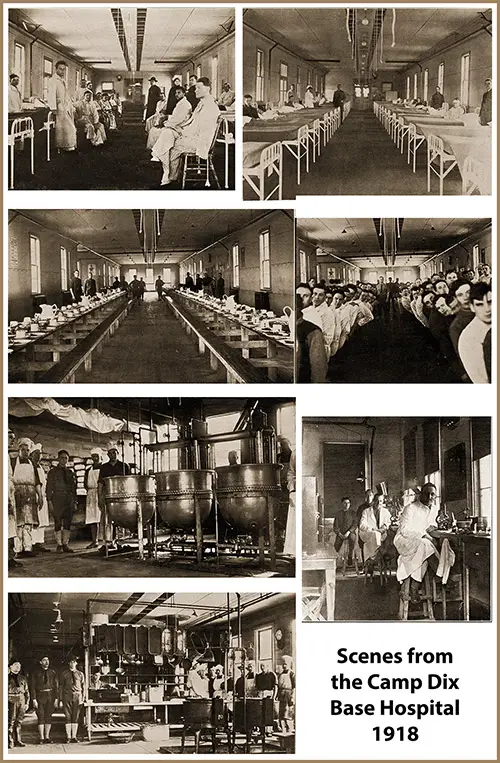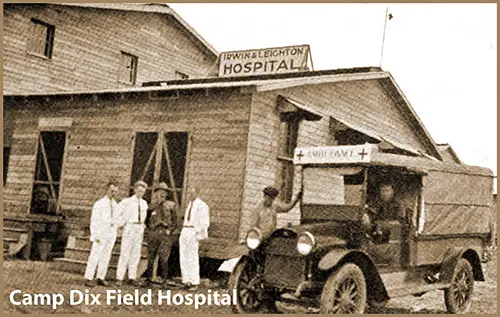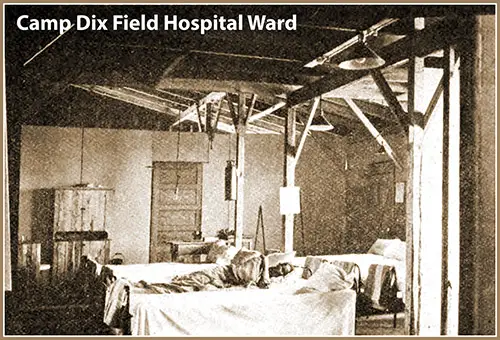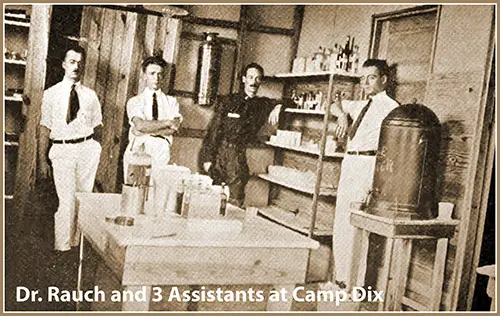The Camp Dix Medical Corps

The Base Hospital at Camp Dix Comprises About 75 Buildings, a Well-appointed Town. On This Page Are Shown Two Typical Wards, Nos. 23 and 31, the Former Showing Many Cheerful Convalescents. A Large Kitchen Is Provided To Feed the Patients, Offering Two Views. This Contains a Battery of Three Aluminum Steam Cookers. The Bacteriological Room of the Hospital Laboratory Is an Interesting Corner. To Look Over the Enemy "Bugs" Under the High-power Microscope, Discover Their Insignia and to What Battalion of the Disease Huns Poison Brigade They Belong, To Be Able To Determine the Best Method for the Doctors' Counter-attack; This Is an Observation Post Fully as Important as Any at the Front. Camp Dix Pictorial Review, 20 April 1918, p. 4. GGA Image ID # 1ce86d7f57
THE most critical element in the fight against disease is sanitation. At Camp Dix, the medical corps has drawn up a set of drastic regulations which must be enforced.
The soldier is required to bathe frequently, shave daily, and keep his clothing in the best condition. The barracks and their vicinity are also kept free from dirt; each morning, a "police squad" is detailed to pick up the accumulated waste. When they have finished their work, not even a burnt match remains.
The medical corps' duties are the supervision of the camp sanitation, the care of the sick and wounded, the physical examination of officers and enlisted men, and the management and control of military hospitals.
Twice daily at the cantonment, there is a "sick-call." when all unwell men go to the regimental infirmary to be examined. If their indisposition is trivial, they are relieved from duty and allowed to remain in their barracks, but they go to the base hospital for treatment if it is serious.
The first picture shows one of the ambulances, with the familiar distinguishing Red Cross on its side. The Red Cross has become a part of the army, and all its equipment is now under government control. Its members are officers or enlisted men of the army. The ambulances are driven by men of the ambulance company, a branch of the headquarters train.
The second picture shows the extent to which sanitation is enforced. To air their bunks properly, each man is required to leave their bunks in the open air while they are at drill.
The third picture shows the main street of the base hospital, which is isolated from the camp. It will hold over a thousand men and is as completely equipped as a city hospital.
The fourth picture shows the arrangement in the depth of the wards. Each has a screened porch to which the bunks of the men are brought if conditions are favorable.
The Field Hospital at Camp Dix

The Camp Dix Irwin & Leighton Field Hospital at Camp Dix. The Camp Dix News, 25 August 1917, p. 8. GGA Image ID # 1ce5e44d67
By S. EMMART RAUCH, M.D.
Characteristic of the work at Camp Dix, the Field Hospital was completed and equipped in record time.
The kitchen end of one of the first barracks finished was transformed into a dispensary where accident and medical cases could be treated. Later, the remainder of the first floor was taken to form the hospital ward, and at present contains fifteen beds.
As the number of men employed at the Camp increased it was found necessary to establish a clinical office, where medical cases are treated for a nominal sum. A laboratory is being fitted up, and will contain, besides other apparatus, an oil immersion microscope for the examination of specimens.
The dispensary was designed primarily to give first aid to the injured. It is supplied with all necessary surgical instruments and appliances, and is ready for any emergency that may arise. Among the unique features of this place is a sterilizer which is able to heat five gallons of water in a few minutes.
Seeing the necessity for hot water, the idea was conceived of enclosing a vessel and gasoline blowtorch inside an asbestos-lined wooden chamber. Just another example of Yankee ingenuity when put to the scratch.
A ward patient is kept under observation for twenty-four hours, and if his condition makes it necessary he is removed to the Burlington County Hospital at Mt. Holly.
Inoculations against typhoid fever are made every Saturday afternoon and at certain times during the week, lip to date about four hundred men have received this treatment. Patients subject to lockjaw are inoculated with anti-tetanus serum.
The medical staff, in addition to its other duties, examines every day the physical condition of about twenty-five applicants for cafeteria work. This examination is thorough, and includes a blood test. Every precaution is made not to admit any man who is not in perfect health.

Camp Dix Field Hospital Ward. The Camp Dix News, 25 August 1917, p. 8. GGA Image ID # 1ce62bb889
The field hospital maintains a motor-ambulance, which assures the badly injured being brought in for first aid a few minutes after the accident.
The Hospital work is probably more varied than any other activity in the camp, as it includes everything from pulling teeth to autopsies—with almost everything else in between.

Dr. Rauch and Three Assistants at Camp Dix. The Camp Dix News, 25 August 1917, p. 8. GGA Image ID # 1ce658f718
S. Emmart Rauch, M.D., "The Field Hospital," in The Camp Dix News, Vol. I, No. 2, 25 August 1917, p. 8
